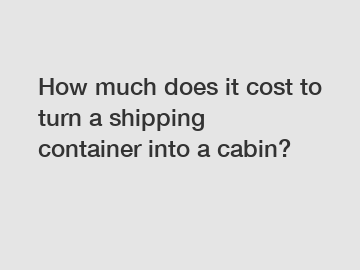How much does it cost to turn a shipping container into a cabin?
How much does it cost to turn a shipping container into a cabin?
Shipping container homes have become increasingly popular in recent years, offering a unique, cost-effective, and eco-friendly housing solution. The concept of repurposing shipping containers into comfortable living spaces has captured the imagination of many individuals looking for an alternative way of living. If you're considering transforming a shipping container into a cozy cabin, you might be wondering about the costs involved. In this article, we will explore the different aspects that contribute to the overall expenses of this endeavor, enabling you to make an informed decision.
1. Initial Purchase Cost:

To begin your journey of transforming a shipping container into a cabin, you'll need to acquire a container. The price of a shipping container can vary depending on various factors such as size, condition, and location. On average, a used container can cost anywhere between $1,200 and $4,500, while a brand new one can range from $3,000 to $7,500. It's essential to thoroughly inspect the container for any damages or structural issues before finalizing the purchase.
2. Transportation and Delivery:
Once you've purchased a shipping container, the next step is to transport it to your desired location. The cost of transportation will depend on the distance and accessibility of your chosen spot. If your site is easy to reach, the delivery expenses can be relatively low. However, remote or hard-to-access locations may incur higher transportation fees. On average, transportation costs can range from $500 to $5,000, so it's crucial to consider the location carefully.
3. Site Preparation:
Before the container can be placed on your site, you'll need to prepare the land. Site preparation can involve grading the land, creating a foundation, and ensuring proper drainage. The cost of site preparation can vary greatly, depending on the condition of the land and the complexity of the work required. You may need to hire professionals, such as landscapers or contractors, to assist with this process. Generally, site preparation costs can range from $1,500 to $10,000 or more.
4. Modifications and Insulation:
Transforming a shipping container into a livable space involves making various modifications to ensure comfort and functionality. This includes installing doors, windows, electrical wiring, plumbing, insulation, and ventilation systems. The cost of modifications will depend on your specific requirements and the complexity of the work involved. On average, expect to spend approximately $50 to $150 per square foot for modifications. Insulation, a crucial element for temperature control, can range from $1,500 to $4,500, depending on the insulation material and the size of the container.
5. Interior Finishes:
To create a cabin-like ambiance, you'll want to invest in interior finishes such as flooring, wall cladding, cabinetry, and fixtures. The cost of interior finishes can vary significantly depending on your preferences, the quality of materials, and the size of the space. On average, interior finishes can range from $5,000 to $20,000 or more. It's important to plan your budget accordingly and prioritize areas where you're willing to splurge or save.
6. Additional Costs:
Apart from the major expenses mentioned above, it's essential to budget for additional costs that may arise during the transformation process. These can include permits and inspections, septic or sewer connections, landscaping, furniture, appliances, and exterior features such as decks or patios. The prices for these additional costs vary greatly and should be considered when estimating the overall budget for your shipping container cabin project.
In conclusion, turning a shipping container into a cabin involves various costs that should be carefully considered. The total expenses can range anywhere from $10,000 to $100,000, depending on factors like the size of the container, site location, modifications required, and the level of finishes. It's crucial to plan your budget meticulously and consult with professionals, such as architects or contractors, to ensure a successful and cost-effective transformation. Despite the initial investment, creating a shipping container cabin can be an exciting and rewarding endeavor, providing a unique and sustainable dwelling that suits your needs and preferences.
If you are looking for more details, kindly visit 20ft Expandable House, Expandable Prefab Homes, Container Granny Flat for Sale.


